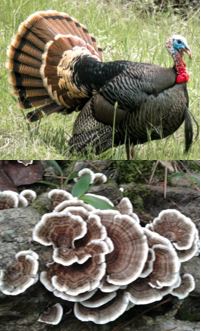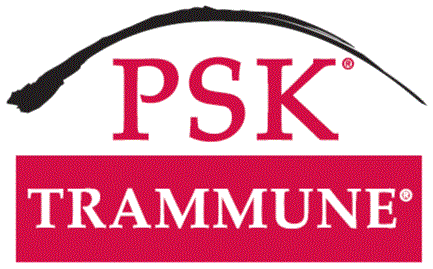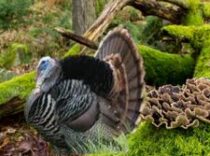Trametes Medicinal Mushroom – A Valued Medicine from History
History of Mushrooms
Throughout history Mushrooms have been an essential source of food & herbal medicine for centuries. They are nutrient-rich, containing essential amino acids, minerals, dietary fibre, and many bioactive compounds. Medicinal mushrooms have been used in many different cultures, but they were especially valued In China, Korea & Japan. In China, medicinal mushrooms were used at least 2000 years ago by Chinese healers. As knowledge developed, specific species became highly valued as mushroom medicines. Of the 20,000 species recorded, one is the best known commercially for its medicinal applications.
Trametes versicolor – Why is it called the turkey tail mushroom?

The colourful waves of the Trametes mushroom resemble the fan of a Turkeys Tail.
This highly valued medicinal mushroom is called Trametes Versicolor. It is known as Coriolus Versicolor, Yun Zhi (Cloud Mushroom), Kawaratake (Mushroom by the River) Polystictus Versicolor. More recently, however, it has also become known as the Turkey Tail mushroom due to the fanlike wavy bands of dark and light colours that resemble a Turkey’s Tail.
Trametes Versicolor, when found in the wild, will often grow in dense overlapping clusters on dead or living trees. They may be found in cool wooded temperate regions of forest and can sometimes have a velvety surface.
Can you eat Trametes versicolor?
They are not in the same category as culinary mushrooms, such as a delicious, buttery, soft white button, or oyster mushroom many of us enjoy on a grilled piece of sourdough. The Trametes Versicolor medicinal mushroom has a rubbery fruiting body that is quite difficult to eat. So how can you gain a benefit from this medicinal mushroom? It’s all in the preparation, which goes back to its early medical use as a herbal Tea.
Preparation as a Herbal Tea to Dispel dampness
Dating back at least two millennia, traditional herbalists would gather Trametes Versicolor mushrooms from the forest. The fruit body was then dried and ground into a powder; herbalists would then take this powder and make it into tea. This simple hot water decoction prepared according to the traditional Chinese pharmacopoeia was used to dispel dampness, which means a body with excessive moisture. In simple terms, this could be like saying a body was waterlogged.
Many things can cause this excess water, including the food we eat or even environmental moisture, making the body more susceptible to developing dampness.
Mushroom Medicine – Polysaccharides help support the immune system
After many years of medicinal use, the Trametes Versicolor mushroom developed a reputation for a range of therapeutic benefits. Researchers eventually discovered that the main therapeutic ingredients in these extracts are complex polysaccharides, including those bound to core proteins. It was the polysaccharides bound to proteins that appeared to be intricately linked to immune system enhancement.
Thanks to Traditional Herbalists who passed on their knowledge from generation to generation, they laid the groundwork for future research into the world of mushroom medicine.




